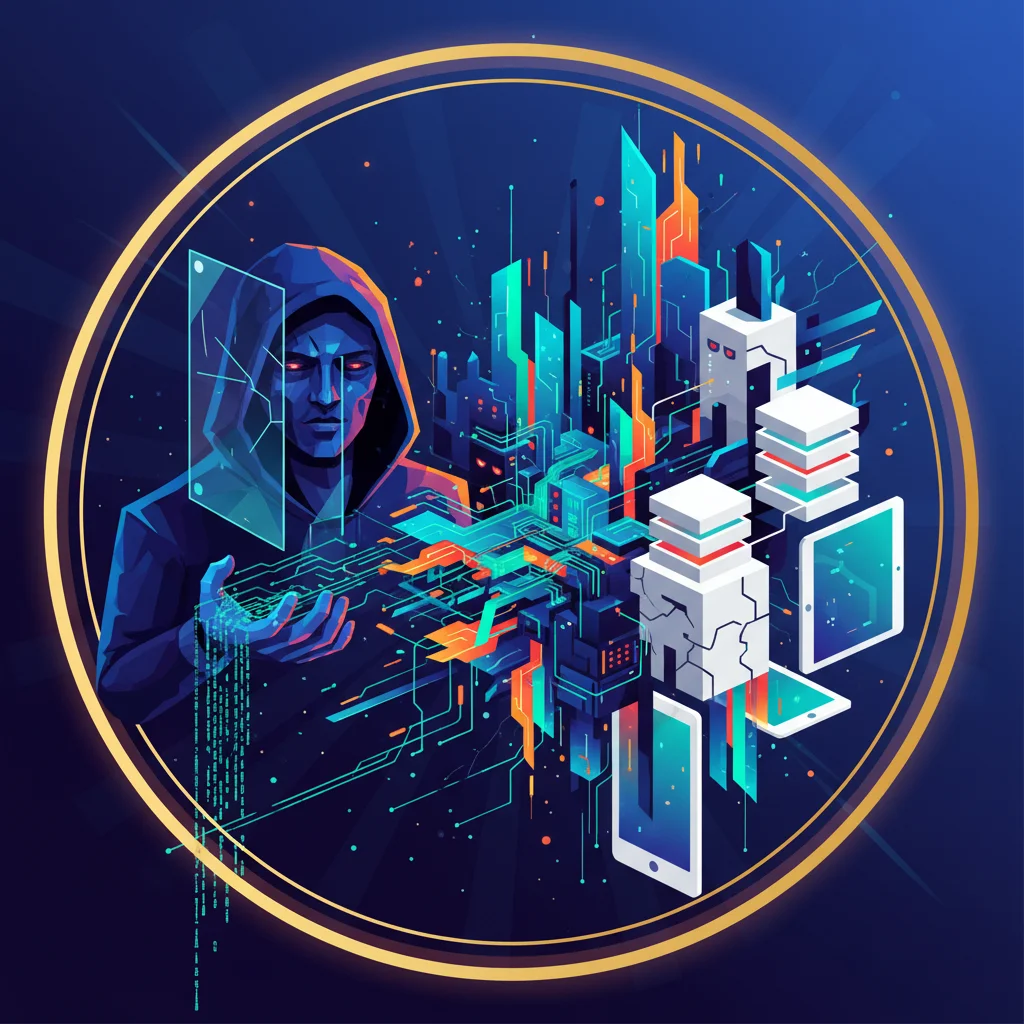
Confessions of a Cyber Kingpin: Inside the Business of Hacking and What It Means for Your Tech Startup
What if a global, multi-million-dollar tech enterprise wasn’t built on innovation and customer delight, but on digital extortion and chaos? What if its departments, programmers, and managers operated not from a sleek Silicon Valley campus, but from the shadows of the internet? This isn’t a dystopian movie plot. This was the reality of Trickbot, one of the most destructive cyber-crime gangs in history. And for the first time, one of its masterminds is talking.
In an exclusive interview with the BBC from a US prison, a former Trickbot leader, known only as “Aleksey,” has pulled back the curtain on the gang’s sophisticated operations. His story isn’t just a fascinating glimpse into the criminal underworld; it’s a crucial wake-up call for every developer, entrepreneur, and tech professional. It reveals how a group of talented programmers built a criminal empire that brought hospitals to a standstill and left a trail of financial ruin, and how their methods provide a dark mirror to the legitimate tech world.
Let’s deconstruct the anatomy of this cyber-crime powerhouse and extract the critical lessons for protecting our own software, startups, and digital infrastructure.
From Programming Challenge to Criminal Enterprise
Every startup has an origin story. Trickbot’s began not in a garage, but on clandestine online forums. Aleksey, a skilled Russian programmer, didn’t set out to become an international criminal. He describes his initial involvement as being drawn to a “technical challenge.” This is a sentiment many in the programming and tech community can understand—the magnetic pull of a complex problem waiting to be solved.
However, this intellectual curiosity soon spiraled into a lucrative criminal venture. The group he joined evolved from creating a banking Trojan—malware designed to steal financial credentials—into developing the highly versatile and dangerous Trickbot software. This wasn’t just a piece of malicious code; it was the engine of a sprawling criminal ecosystem. The gang’s journey from a niche tool to a full-blown platform highlights a terrifying parallel to legitimate tech: the drive to scale, innovate, and dominate a market. Their market just happened to be crime.
The Dark SaaS: How Trickbot Operated Like a Tech Company
Forget the stereotype of a lone hacker in a dark hoodie. Trickbot was structured with the unnerving professionalism of a modern tech company. They had specialized departments, salaried employees, performance bonuses, and a clear organizational hierarchy. Their business model was essentially “Cyber-crime-as-a-Service,” a dark twist on the SaaS model that dominates the legitimate software industry today.
This organizational structure allowed them to operate with ruthless efficiency and scale. Here’s a breakdown of their corporate-like structure:
| Department / Role | Function in the Trickbot “Business” |
|---|---|
| The “A-Team” (Leadership) | Set strategy, managed finances, and directed the overall operation. Equivalent to a C-suite or board of directors. |
| Programmers / Developers | Wrote and updated the core Trickbot malware, adding new features and evading detection. Their “product development” team. |
| Testers (QA) | Ensured the malware worked flawlessly across different systems and that new updates didn’t break functionality. |
| “Crypters” | Specialized in obfuscating the code to make it undetectable by antivirus software, a crucial part of their “go-to-market” strategy. |
| Managers | Oversaw teams of developers and testers, ensuring deadlines were met and the “product” remained effective. |
Their primary “service” was providing access. Once Trickbot infected a computer network, Aleksey’s gang didn’t always carry out the final, devastating attack themselves. Instead, they sold access to the compromised networks to other criminal groups. Their most notorious clients were ransomware gangs like Conti and Ryuk, who would then encrypt the victim’s files and demand millions in payment. Trickbot was the key, and they sold copies to the most vicious burglars on the web.
The Anatomy of a Global Attack
The gang’s attack vector was deceptively simple: a well-crafted phishing email. Using automation to send out millions of messages, they only needed a handful of people to click a malicious link or open a compromised attachment. Once a single machine was infected, Trickbot would spread laterally across the network, silently mapping out the digital infrastructure and exfiltrating data.
Aleksey claims he and the other leaders tried to steer clear of “socially important targets” like hospitals. Yet, as he admitted, once you release self-propagating software into the wild, control is an illusion. Trickbot was found to be a key player in attacks that crippled healthcare systems during the height of the COVID-19 pandemic, a fact that Aleksey now calls a “huge sin” (source). This demonstrates a critical lesson in software development: the law of unintended consequences is amplified exponentially when ethics are absent.
The Trickbot model is a terrifying blueprint for the future of cybercrime. Imagine this same organizational efficiency combined with AI-powered attack tools. We could see AI that writes its own polymorphic malware, learns from its failures in real-time to breach networks, and even generates hyper-personalized phishing emails that are indistinguishable from legitimate communication. The fight for cybersecurity is no longer just about building stronger walls; it’s an arms race of automation and intelligence. Aleksey’s confession isn’t just a look at the past; it’s a preview of the adversary of tomorrow.
The Takedown: A Alliance Against Chaos
The sheer scale of Trickbot’s operation eventually drew the attention of the highest levels of international law enforcement and the tech industry. In a landmark operation, US Cyber Command and Microsoft joined forces to disrupt Trickbot’s cloud-based command-and-control infrastructure. They didn’t just block a server; they systematically dismantled the digital nervous system of the entire operation (source). This public-private partnership was a critical blow, crippling the gang’s ability to coordinate their attacks.
Aleksey himself was eventually arrested, not in a dramatic raid, but while traveling through South Korea. His capture and subsequent cooperation with the FBI provide invaluable intelligence, but the hydra-like nature of cybercrime means that the threat is far from over. The developers, the methods, and the infrastructure can be repurposed and redeployed by new groups.
AI Isn't Firing You… Yet. The Real Story Behind Tech's Layoff Storm
Actionable Lessons for the Modern Tech World
So, what can we learn from the rise and fall of a cyber-crime empire? Aleksey’s story is more than a cautionary tale; it’s a practical security briefing for anyone building, running, or investing in technology.
Here are key takeaways and defensive strategies for startups, developers, and entrepreneurs:
| Audience | Key Lesson & Actionable Advice |
|---|---|
| Developers & Programmers | Ethics are not optional. The line between a “technical challenge” and a harmful tool is crossed when you ignore the impact on people. Embrace secure coding practices from day one. Understand that every line of code has real-world consequences. Prioritize security in your development lifecycle (DevSecOps). |
| Startups & Entrepreneurs | You are a target. Trickbot didn’t just go after Fortune 500s; they sought any vulnerable network. Secure your cloud infrastructure, implement multi-factor authentication (MFA) everywhere, and establish a robust incident response plan before you need one. Your innovation is only as strong as its security. |
| Tech Leaders & Managers | Cultivate a culture of security. Just as Trickbot had a culture of criminal efficiency, legitimate businesses must build a culture of security awareness. This includes regular training on phishing, social engineering, and proper data handling. Security is a shared responsibility, not just an IT problem. |
The sophistication of gangs like Trickbot means that basic defenses are no longer enough. Businesses must adopt a proactive, multi-layered cybersecurity posture that assumes a breach is not a matter of “if,” but “when.”
The Ghost in the Machine: Why We Must Build Guardrails for Artificial Intelligence
The Enduring Legacy of Trickbot
Aleksey is now paying the price for his crimes, cooperating with the very authorities he once evaded. He expresses a degree of remorse, but the damage is done. Billions of dollars were lost, critical infrastructure was paralyzed, and trust in our digital world was eroded.
His confession is a stark reminder that the greatest threats to our digital lives are not just lines of code, but the organized, well-funded, and highly skilled human enterprises behind them. They operate like us, they innovate like us, and they are constantly evolving. As we push the boundaries of technology with AI, automation, and ever-more-integrated software, we must do so with the sober understanding that for every tool we create for good, there is a shadow version being forged for ill. The battle for cybersecurity is a battle of innovation, and it’s one we can’t afford to lose.


